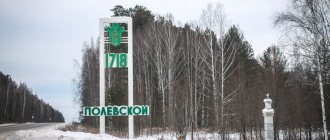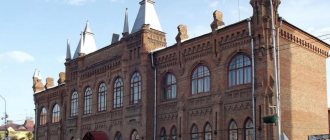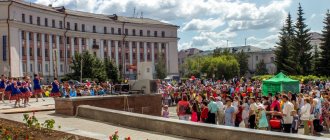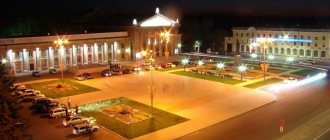Small county towns from the Russian outback have a special, heart-wrenching beauty, touching, tender, leaving a deep imprint in the memory. This is the city of Mtsensk and its attractions, a small regional center in the Oryol region, in the past - a border fortress on the way to the Chernigov principality. Residents have a favorite reminder to every tourist - their city is a whole year older than Moscow itself. Over its 870-year history, the town was part of several state entities - Moscow, Lithuania, wandered from the Kyiv province to Belgorod, then Oryol, and was subjected to devastating attacks by Batu’s troops, steppe Tatars, and fascist invaders. All historical vicissitudes erased the sights from the face of Mtsensk, replacing them with faceless Soviet buildings. However, today's tourist will find something to see in one of the oldest Russian towns.
Church of the Ascension
The Church of the Ascension of the Lord is located on the banks of the Mtsna River. The construction of the religious site took place approximately at the end of the 17th – beginning of the 18th centuries. Initially, the church was a monastery cathedral.
The temple has three altars, with the Ascension of the Lord considered one of the most important for pilgrims. The other two altars are St. Michael the Archangel and St. John the Baptist.
At the end of April 1757, the monastery complex burned down. It was subsequently restored thanks to Rodion Yazykov. A few years later the monastery was closed and turned into a parish church.
The temple began to be used as a club in 1938. Moreover, during World War II, German troops turned the building, which previously served for religious purposes, into a firing point. Serious damage was caused during the fighting.
After the war, there was a risk that the church would be completely demolished. This event could have occurred during the construction of the Moscow-Simferopol transport highway. However, local historian M.V. Kaplinsky accidentally met Grigory Grigorievich Pushkin, a descendant of the famous poet.
As a result, the building was presented as the house of boyar Pushkin. This is what contributed to the preservation of the monument and restoration work. In 1992, the Church of the Ascension of the Lord was transferred to the community of believers, and 3 years later the re-opening of the religious monastery took place.
State Memorial and Natural Museum-Reserve of I. S. Turgenev “Spasskoye-Lutovinovo”
At a distance of 12 km from Mtsensk there is an estate intended for an exhibition revealing interesting facets of the life of I. S. Turgenev.
The date of creation of the museum-estate is considered to be September 16, 1921. In 1937, the museum center became a branch of the Oryol State Literary Museum of I. S. Turgenev. At the same time, the museum-reserve includes memorial buildings, valuable exhibits and even a manor park complex. In fact, the main wealth is the original Turgenev items. In addition, since 2015, halls have been operating that allow you to learn about the various stages of Turgenev’s creative activity and present the world of his works “Notes of a Hunter,” “Mysterious Tales,” and “Prose Poems.”
Location: Spasskoye-Lutovinovo, Muzeynaya street - 3.
First Guards Tankmen's Square
The official opening date of the square is May 8, 1975. The opening was timed to coincide with Victory Day, because for the battles near Mtsensk the 4th Tank Brigade was noted in the report and even received valuable awards. The square turned out to be a worthy reminder of what grandiose feats were accomplished by the fighters to liberate the country. In addition, it was the 4th Tank Brigade that contributed to the further development of the Tank Guard of the Red Army, as a result of which it deserved memory and respect.
Location: Mira Street - 37.
City's legends
Thanks to the Russian writer N. S. Leskov, who wrote the essay “Lady Macbeth of Mtsensk,” and subsequent film adaptations and theatrical productions, Mtsensk also arouses interest among literature lovers and philologists. It is believed that Katerina Izmailova once lived in house No. 10 on what is now Mira Street, who became an almost complete prototype of Leskov’s heroine. Literary scholars prove that this is just a legend, but travelers don’t want to believe it, so Mira Street has become a kind of attraction. You can walk along it, imagining the life of a provincial Russian city in the first half of the 19th century.
Locomotive-monument L-1822
The locomotive-monument L-1822 was installed in Mtsensk on July 20, 2003. The attraction is located on the city station square.
The locomotive was built in 1952. Its creator is the Kolomna plant. At the same time, the installation of the monument was an achievement of the search students representing the 8th school.
The steam locomotive is painted black. Moreover, its contours are highlighted with red and white paint. As a result, the object turned out to be a worthy reminder of the exploits of the railway workers who participated in the Second World War on armored trains and liberated Mtsensk from the German invaders.
Railway workers of the Oryol region tried to recreate a real steam locomotive L-1822, as well as a platform intended for the installation of artillery guns, and a heated car where soldiers and officers were located. A Soviet-era anti-aircraft gun is installed on the carriage platform.
Location: station square.
Art Gallery
The art gallery has been operating in Mtsensk since the end of July 1999. Various exhibitions of famous artists from many Russian cities are held here. On the opening day of the gallery, the talented Tula artist F.N. Demin presented more than 30 paintings and worthy graphic works.
Location: Turgenev street - 108.
Souvenirs from Mtsensk
Mtsensk, like almost any other city, invites guests to take away all kinds of magnets, plates and bells as souvenirs. But the famous Mtsensk lace will be a real, authentic gift. The lace industry originated in Mtsensk back in the 18th century; local lace was sold in England, France, Turkey and, under the guise of foreign ones, in Russia. The Tenishevskaya school of lacemakers was built in 1899, and from the very opening it supplied the imperial court with lace.
Amazingly beautiful products made in ancient ways, using bobbins, make a pleasant contrast with consumer goods and will remind their owners of Mtsensk for a long time.
Mtsensk Local Lore Museum named after. G.F. Solovyova
The local history museum began its work in 1919. Initially, it was the Mtsensk Museum of Visual Aids and the local region. Unfortunately, in 1941 the cultural institution was destroyed and it was restored only 19 years later.
The Mtsensk Folk Museum is located in an ordinary 5-story building. However, the presented exhibition reveals interesting facets of the history of the region, features of the development of crafts and trade activities, the nuances of public life, and military periods.
Location: Turgenev street - 104.
Historical facts
Mtsensk is one year older than Moscow itself. Residents of the city never tire of reminding every tourist about this.
- 1146 - the first mention in the Nikon Chronicle of the city, which was part of the Chernigov principality.
- In 1238 it was destroyed by the hordes of Batu.
- Since 1246 - as part of the Novosilsk principality.
- Since 1320 - under the rule of the Grand Duchy of Lithuania.
- In 1492, the city was conquered by the Russian army under the leadership of governor Theodore Obolensky.
- 1505 - Mtsensk territorially belongs to the Moscow state.
- In the 16th-17th centuries, the Mtsensk fortress became one of the largest military fortifications on the southern borders.
- Since 1708, the city has been part of the Kyiv province, since 1719 - the Oryol province, since 1727 - the Belgorod province.
- Since 1778 - a district town of the Oryol governorship, and since 1796 - of the Oryol province.
- In 1868, a branch of the Moscow-Kursk road that was being built passed through the city.
- In October 1919 it was captured by the White Guards, who soon retreated. Mtsensk became the extreme point of the campaign against Moscow.
- Since 1925 it has been declared a city, since 1928 - the center of the district of the Oryol region.
- In 1943, bloody battles took place for Mtsensk; on July 20, the city was liberated by units of the Bryansk Front.
- Since 1963 it has belonged to the settlements of regional subordination, and since January 2006 it has been a district of the “City of Mtsensk”.
Chapel of St. Nicholas the Wonderworker
The chapel was built on the site of the Cathedral of St. Nicholas the Wonderworker, which was destroyed. The cathedral has been in operation since 1841, but in the 1930s it did not survive the trials. Previously, St. Nicholas Cathedral was located on this site, the construction of which dates back to 1672 - 1681.
The Cathedral of St. Nicholas the Wonderworker was closed in the 1930s, after which it was blown up. Only 30 years later it was possible to dismantle the ruins of the religious monastery. In 1996, when Mtsensk turned 850 years old, the St. Nicholas Chapel was built.
Ancient temples on the banks of Zushi
The main attractions of Mtsensk are the churches; it is rightly called the city of ancient churches. Their photos and descriptions can be found on Internet sites and in guidebooks for the Oryol region and Mtsensk region.
Peter and Paul Monastery
The architectural complex of the Peter and Paul Monastery, founded in the 16th century, is noteworthy. It operated until 1923, then it suffered the fate of most religious institutions - closure and repurposing into a prison for dispossessed peasants. To this day, only the Znamenskaya Church, a residential building with monks’ cells and fragments of the monastery fence have survived. The altar apses alone remind of the Intercession Cathedral, another ancient landmark of this place.
Nikitskaya Church
The Nikitsky Church is famous for the fact that the body of Emperor Alexander I, who died suddenly in Taganrog, rested there for three days on the way to Moscow.
Ascension Church
The Church of the Ascension rises on the site where a convent was once located, which burned down at the turn of the 17th and 18th centuries. The temple was almost demolished immediately after the Great Patriotic War during the construction of the Simferopol highway, but the building was saved by the legend that it was allegedly considered the house church of some ancestor of the great Russian poet A.S. Pushkin.
Chapel of St. Nicholas the Wonderworker
On a high coastal hill on the site of the St. Nicholas Cathedral destroyed by an explosion in the 30s, a modern new building rises - the Chapel of St. Nicholas the Wonderworker.
Source of John the Baptist
Orthodox residents of the town, visiting pilgrims and ordinary tourists try not to ignore visiting the source of John the Baptist. It is located at the foot of the Cathedral Mountain, where the Zusha and Metsna rivers connect, one of the popular attractions of the city of Mtsensk. There is a bathhouse at the spring; a narrow path winds down the slope to it.







